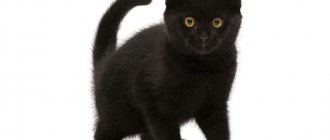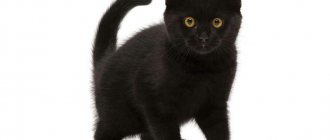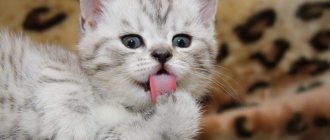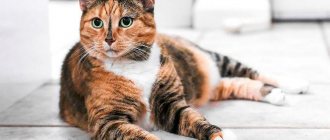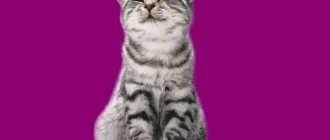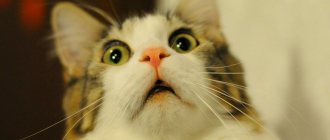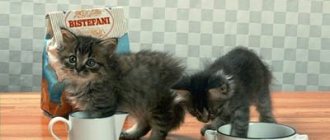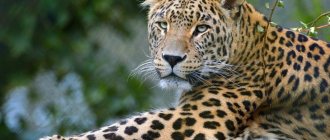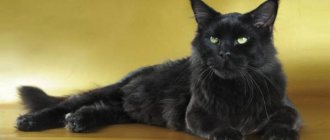Nature has endowed all cats with a difficult character, but black cats are also distinguished by their unusual appearance. People blame these animals for all misfortunes and superstitiously try not to cross them on the road.
Apparently, this is how the subconscious fear of the dizzying beauty of animals in shiny coal-colored coats is expressed. But this color in different combinations is found in almost all cat breeds.
Genetics of black color
The pigment pheomelanin is responsible for the red color, and eumelanin is responsible for the black color. In cat hair they are presented in the form of granules, the shape, quantity and location of which determine the color shade. Let’s leave the first one (red) aside, and consider the second one in detail.
- In black cat breeds, the B (black) gene is responsible for color. In the genotype of an animal, it can be represented in three alleles (species): dominant B, recessive b and bl.
- In the dominant state, the gene forms almost round (slightly elongated at the poles) eumelanin granules with a dense arrangement in the hairs. This gives a rich black color.
- The recessive allele b of the same gene stretches the pigment granules and moves them away from each other. It turns out to be a chocolate shade.
- The final form of bl is even more expanded eumelanin capsules and a sparse arrangement. On the hair this gives the color of cinnamon (cinnamon), characteristic of many breeds.
All other characteristics do not play a role in the color of interest - a large black cat is necessarily a carrier of the dominant B gene.
This is interesting! In black cats, there is no relationship between coat color and the sex of the animal. Their genes are not connected to the chromosomes that are responsible for dividing into “boys” and “girls.”
Sphinx
Thanks to its hairless body, the Sphynx has become one of the most recognizable breeds. These striking hairless creatures are medium in size; Characteristic features of their appearance are large ears and wrinkled skin.
Sphinxes amaze with the intense gaze of their large eyes, which against the backdrop of a bald head seem even more significant.
Despite the fact that representatives of this breed appear hairless, their body can be covered with fluff, creating the effect of “corduroy” skin.
bald body does not relieve the owner of caring for it, because... Due to the lack of hair, the animal is unable to absorb the natural oils it secretes.
What the sphinx lacks in fur, they make up for it with their extraordinary personality. They are sociable, energetic and playful. Curious creatures are characterized by mischievous behavior and a love of teasing toys and puzzles.
Characteristic eye color
The genetics of the pupil is less studied than the properties of fur. Researchers suggest the presence of a color gene and some polygenes that are located outside the studied structures and affect the characteristic features of the organism.
Felinologists identify three most common combinations:
- Black cats with green (grn) eyes are a classic color combination.
- The second group is orange, brown and amber-honey (org) eyes.
- The final position is in the copper color range (cpr). Fairytale black cats with red eyes actually come from this category.
When recessive alleles (b, bl) come into play and various shades appear on the cat's coat, the pupil color combinations automatically dilate. But absolutely black cats have only the three listed eye colors.
This is interesting! Black coat color is never ideal. It all depends only on the degree of its saturation, which hides some natural pigmentation flaws.
American Curl
The most characteristic feature of the breed are the charming ears, which are the result of a spontaneous natural mutation. This breed is especially fond of children, probably because it loves to play and socialize (and doesn't like to be left alone).
- Folk signs about the weather
- How to get rid of papilloma at home
- Beef jellied meat - step-by-step recipes with photos. How to cook and how long to cook beef jellied meat
Bombay cat: black standard breed
Bombays are short-haired black cats, fit, graceful, with shiny golden-copper eyes. Their coat has a glossy satin texture, it is evenly colored along the entire length of the hair and lies tightly to the body. The long tail makes the miniature animal look like a wild predator.
The selection was carried out in the USA, where felinologists pursued two goals. Firstly, this is the desire to consolidate the obligatory black color in hereditary characteristics. Secondly, they wanted to obtain an external resemblance to a panther.
The parent breeds were Burmese and representatives of the American Shorthair cat. It took 4 generations of kittens to breed to achieve a positive result.
Bombays are called the most beautiful black cats. Their color must be uniform from root to tip, and uncolored white patches are considered a serious reason for disqualification.
This is interesting! Bombay kittens are born with small spots and bright blue eyes. As they grow older, the animals change color, get rid of alien light patches on their coats, and the color of their eyes becomes golden.
Sacred Burma, Ragdoll and Ragamuffin
These breeds have family ties, when compared with human ones, like grandmothers, daughters and granddaughters: the Burmese cat is the “primary source” from which ragdolls and ragamuffins originated. Moreover, if the Burmese and Ragdoll have blue eyes, then the Ragamuffins can have them of any color; blue and dark blue are simply more common.
The Burmese cat is an ancient Tibetan breed, whose representatives lived in monasteries and were considered the reincarnation of the souls of deceased monks. Their distinctive feature is white “socks”, which are not typical for Thai and Siamese cats, which Burmese cats resemble.
According to legend, “sacred Burma” acquired them as a result of a miracle - when a cat, guarding a golden statue in a temple, jumped on the head of a harrier-haired monk. The whiteness of his hair was transferred to her paws, and since then all representatives of the breed have worn this insignia.
Ragdolls, descended from Burmese and Persians, are distinguished by a very even and non-militant disposition. In the hands of a person, they completely relax and are very loyal to the caresses of their owners, hence the name, which means “rag doll”.
The breed became so popular due to its gentle character and charming appearance that breeders decided to increase the number of such cats and diversify their colors, so they began to cross Ragdolls with outbred cats, selecting kittens of interesting colors for breeding. This is how the ragamuffins (“ragamuffins”, English - Ed.) appeared. Their eye color is often blue and blue, but for some Ragamuffin colors (such as sepia) this is not allowed.
Breeds with acceptable black coloration
In nature, this color is not unique among cats and is often found in any breeding groups. The dominant B gene is stably present both in native breeds (which were formed under natural conditions) and in various hybrid communities or among outbred animals.
big black cats coexist with equally charcoal-shiny homeless strays, and this picture never surprises anyone.
American Bobtail
A rare breed of tailless cats. Their breeding began in the 60s in Arizona and continues to the present day. Among the parents of the American Bobtail are Siamese, Burmese, and Himalayan cats. A distinctive feature of the breed is the absence of a tail, and the color fades into the background.
More often than others, grey-red kittens with a tabby pattern (stripes and spots) are born. Fluffy black cats with a small overgrown tassel in place of the tail are less common, but it all depends on the parents and genetic predisposition.
The mixture of different breeds in the origin of the American Bobtail suggests the appearance of offspring of the most unusual colors, among which there are both solid black colors and combinations of black and white.
Siberian breed: black cat with green eyes
An indigenous Russian cat, which can be recognized as a national treasure of the country. The history of origin is unknown for certain, like most other breeds. But rich long fur, dense undercoat and adaptability to harsh climates indicate that the animal has perfectly adapted to its natural habitat.
The solid colors of Siberians come in two colors: red and black. But if the red tones are intersected by a tabby pattern (stripes, spots or blurred marble), then the coat of a long-haired black cat looks very impressive. In total there are more than 200 combined color options.
This is interesting! Siberian cats became the founders of the Neva Masquerade subspecies - a long-haired breed with a characteristic point mask in red or black shades.
Oriental cat
Oriental cats are champions among black breeds in terms of gracefulness. They are very graceful and sophisticated, on high slender legs, with an elongated wedge-shaped muzzle on a long neck and slightly slanting green eyes. In this color, the wool is evenly dyed along the entire length, from the root to the end.
Among representatives of this species, smooth-haired black cats are also often found.
Devon Rex
Devon Rexes are presented in two categories:
- Like many new breeds that gained official recognition in the 20th century, all modern Devons are descended from a kitten found in the litter of a mongrel cat. He had very large ears and curled fur, for these qualities the cat received the name Kirli (curly).
- It is a rare case when literally everything is known about the first animal in the group - Kirli was a black cat with eyes the shade of yellow amber.
Devons are very active pets - they love to climb onto the owner's neck and sit on his shoulders.
Like other representatives of the “eared” group, they are often called elves, hinting at “extraterrestrial” genetics. Among the popular black cat breeds, Devon cats are not considered. The population is small and black is not the most common color.
Turkish Angora
For more than a century, Turkey has had a program to preserve this breed as a national treasure. We are talking about a classic Angora cat with long or semi-long white hair and multi-colored eyes - yellow and green.
These animals began to be called Angora due to their very soft hair, by analogy with the well-known downy goat breed.
The spread around the world and the efforts of breeders have not benefited the classic white color. It is gradually giving way to other colors, and it is not surprising when black-brown cats with different-colored eyes and a fluffy long tail appear at exhibitions.
It must be admitted that in the pure black version, the shaggy Turkish Angora looks very impressive and rich.
Norwegian forest
Representatives of the aboriginal breed live in Northern Europe. One of the legends about its appearance connects the harsh, unpretentious Norwegians with the pampered southern Angora breed, which has adapted to living conditions in a cold climate.
The forest cat is large, with a double coat, dense undercoat and winter “decorations”: a mane, bib, whiskers and warm pants on the hind legs.
The portrait is completed by neat erect ears with tassels and thick pubescence on the inside of the auricle.
Norwegians are large animals that mature only at 4-5 years of age. Any color is allowed in the breed except those that indicate an undesirable crossbreed: fawn, cinnamon, chocolate and others. Large all-black cats are rare, but black and white cats with thick undercoat are common.
This is interesting! The indigenous qualities of the Norwegian forest cat are protected by an international association. Their out-of-breed crossings are allowed only with a separate permission from WCF.
American Curl
There are representatives of this breed with semi-long and short hair. A distinctive feature of Curls are their ears - wide at the base, semicircular at the top, with reverse folded ears at an angle of at least 90°.
There are no separate requirements for coat and eye color, with the exception of color-point colors with a characteristic blue eye color. In other colors, shades from brown to light hazel are acceptable.
Representatives of this breed with pure black hair are rare. The most beautiful black cats come from short-haired parents. Long-haired pets are traditionally presented in black and white.
Important! The American Curl should not be left alone with small children. Careless caresses can damage the fragile structure of the curled ears.
Manx
The main distinguishing feature of the Manx cat is the absence of a tail. The length of what is left of it cannot extend below the hock joint of the hind legs. But more often there are animals with a 3-7 cm “process”.
When breeding animals, they must select one of the parents with a longer tail - two tailless genes lead to the death of the offspring.
Manx cats are allowed any coat color, except for the color-point varieties. Black kittens are rare, but white or tortoiseshell cats are born consistently.
Cymric
The Cimmerian breed is a semi-longhaired version of the Manx. Breeders united kittens with long hair into a separate group, and then they were recognized by international felinological unions.
Black tailless Cymric cats are born with yellow or green eyes and the typical short "broom" for a tail. They easily adapt to the family and get along well with children and pets.
Coal Bengal
To call this cat black is wrong, but to describe it in any other way is stupid. Bengals are an interspecies mix. Their ancestors are domestic cats and wild Bengal cats. The hybrid received an incredibly beautiful spotted color - contrasting black spots on a golden background.
In appearance, they resemble small leopards with a cute face and an independent character.
The Charcoal Bengal's main coat color is bleached black, and the spots and stripes are less pronounced. Another feature of the animal’s appearance is the mask on its face. Its lines are wider than those of standard-colored cats.
Charcoal Bengal charcoals do not have any privileges in the standard and are subject to general expert rules.
Chausie
Another hybrid of a domestic cat (this time an Abyssinian) and a wild jungle cat. The desire to breed a harmless animal with the external signs of a predatory animal does not leave breeders, and they are finding more and more sophisticated ways. Chausie (housey) is another experiment in this chain.
This breed has only three colors:
- silver;
- tabby;
- black.
It is not recommended to keep Chausies in an apartment, as they need space to play and move.
Tabby, or tabby
Tabby is the most ancient coloring, inherited by domestic cats and cats from their wild ancestors. It is distinguished from solids by the presence of a pattern that facilitates mimicry - camouflage to the environment.
Varieties
Tabbies are characterized by zonal hair coloration, which is a uniform alternation of dark and light areas, like on a police baton. Depending on the order of arrangement and appearance of the lines inside the color, 4 subspecies are distinguished:
- Spotted
. The body of the animal is covered with round spots of different sizes. On the tail and in the lower part of the limbs the shape changes to oval and can merge into stripes.
- Marble
, or
classic
. It is a combination of wide spiral stripes diverging on the sides and reminiscent of marble stains. In addition to this feature, the fur coat has spots in the belly area, rings along the tail and paws, as well as 3 stripes in the area of the shoulder blades, similar to the open wings of a butterfly. - brindle
, or
mackerel
. Characterized by thin vertical stripes scattered throughout the body. The rings are found strictly on the tail and limbs, and a continuous dark stripe runs along the spinal column. - Ticked
. This color is found in Abyssinian cats, so it is sometimes carried separately. Its detailed description will be given below.
Another gene is responsible for the appearance of the pattern on the coat - agouti, as well as its possible form, or allele - non-agouti. The first makes the tabby distinguishable, while the second suppresses and disguises it. Thus, in the presence of non-agouti, the tabby turns into a solid.
“ INTERESTING!
Protection from the effects of non-agouti is only provided by the O gene, which is responsible for the red and cream tint. For this reason, all fluffy saffron milk caps have an open pattern, which can only be removed through painstaking breeding work.
Residual tabby in kittens confirms that all whiskered pets are tabbies, but not all are agoutis. Because of this, with solid colors, the pattern disappears immediately after the juvenile molt.
Examples of breeds
The most famous “mustache” with a marbled coat is the short-haired British kitten from the Whiskas advertisement. The presence of spots is typical for savannahs, Ocicats and Bengals. Stripes are the least common. They can be found in the Toyger, a close relative of the Bengal.
Other breeds of black cats
Cats with black fur are found in almost all aboriginal groups. The Maine Coon is a very interesting breed - a champion in height, length and weight. It is in this breed that huge black cats in solid color or with white accents are often found.
Unlike the newly bred mestizos, all natives are good-natured, loyal to people and endowed with good health. The only difficulty is breeding. International expert organizations require compliance with the rules for crossing with other breeds.
Ticked cat colors
The main feature of ticked color in cats is the vagueness of the pattern. It's like he's covered with a light veil. Residual stripes are observed only on the muzzle. Its relationship with other varieties of tabby can be determined by the mesmerizing shimmer of the coat, achieved through zonal hair coloring.
Initially, ticking was found only in “Abyssinians,” but over time, breeders achieved its manifestation in other breeds: Ragamuffin, Chausie, “British,” LaPerma, Cornish Rex, “Oriental,” Manx and others.
The requirements for these animals are much lower than for Abyssinian cats. Their standard allows for open “necklaces” on the neck, the letter “M” on the forehead (scarab sign) and stripes around the paws and tail.
Grooming
Hair care for cats depends on the breed and physical condition of the animal.
- Long-haired and semi-long-haired pets need regular brushing. The procedure must be repeated daily, and during molting - several times a day.
- When caring for a black cat with short hair, special combs and brushes are used that collect small hairs.
Important! The “fur coat” of any cat is an indicator of its health. If the fur loses its shine or falls out excessively, you need to reconsider the animal’s diet and show your pet to a veterinarian.
Color point or acromelanism
The English phrase color point is translated as “color spot”. With this color, kittens are born blue-eyed and almost snow-white. With age, most of their body remains either white or changes to cream, and its extremities (muzzle, tail, ears, paws) darken and acquire more saturated colors:
- tortoiseshells;
- solids;
- tabby
Color point is a form of albinism. It is part of the group of acromelanistic colors that depend on body temperature. So-called points, or dark spots, appear where it is colder. The snow-white appearance of kittens is the result of their high temperature, which is 38.5-39.5°C. In adults, this figure is much lower – 37.5-38.9°C.
Varieties by shade
Depending on the main color of the cat and its point, several subspecies are distinguished in this group. These include:
- blue point - blue;
- chocolate point – brown;
- tortoiseshell (tri-color);
- lilac point – gray-pink;
- seal point – dark brown-gray, close to black;
- red point – red (red);
- cream point – cream (beige);
- tabby point - spotted or striped.
The acromelanism gene can also produce full albinos. Such cats not only have little, but basically no melanin. Because of this, not only their fur coat loses color, but also the iris. Albino cats have either pinkish-red or blue eyes. In the first case, the color comes from blood vessels, and in the second, from reflected rays of light.
Examples of breeds
An alternative name for color point is Siamese. It’s easy to guess that its main owners are the graceful and big-eared Siamese. Acromelanism also appears in their close relatives – Thai and Himalayan cats.
Abyssinian
The Abyssinian cat can become your best friend. Possessing energy, they are always ready to have fun. These animals love to spend time with their owner and try to constantly be near him.
Representatives of this breed have a small muzzle, which makes their almond-shaped eyes appear especially large.
Friendly cats are known for their intelligence and desire to climb high places, so they should be provided with cat trees, posts and other climbing aids.
Abyssins show affection towards family members. Animals also prefer to be in company. If you have a busy lifestyle, it is worth getting a second pet so that your Abyssinian cat does not get bored alone.
